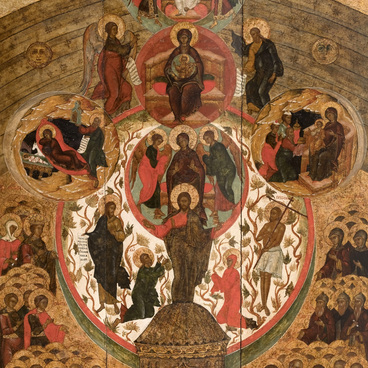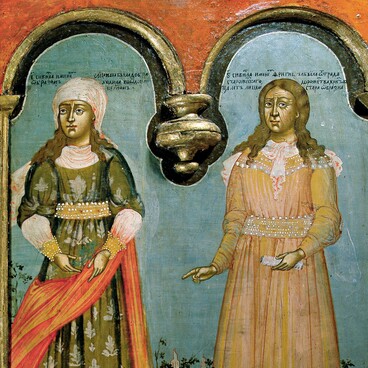These Royal Doors were made in 16-17th centuries. The Royal Doors is an indispensable part of an orthodox church. They serve as the main entrance to the altar and are always situated in the center of the altar barrier or the iconostasis.
The doors are called Royal because during a church service the King of Glory (Jesus Christ) goes through them. The symbols of Jesus Christ are the Holy Sacraments that are brought out from the altar by the priest. Sometimes the Royal doors are called the Holy Doors or the Heaven Doors as the church altar represents a symbolic concept of paradise in the orthodox traditions.
Earlier these Royal Doors were set in the Murom Trinity monastery. There are several painting layers on them. The base layer was painted in the 16th century and only its fragments remain until our days. During the 17th century the painting was renewed regularly. The influence of the second half of the 17th century can be noticed in the silver crowns and in the engraved plates that cover the background of the scenes.
The depictions of the Royal Gates with the Annunciation on them were the most common in Byzantium. The Royal Doors of the Russian iconostases can be divided into two types. The first one depicts saints Basil the Great and John the Chrysostom, the other one – the four evangelists.
The depiction of the Annunciation on the altar doors has a great dogmatic and liturgical meaning. The Annunciation is the moment when the God was incarnated from the Virgin Mary. In the Christian traditions a term ‘the door enclosed’ is used, according to the prophecy of Ezekiel only God can pass through these doors. The Annunciation is interpreted as the beginning of the humanity salvation initiated by the Mother of God. She opened for the people the Heaven Gates that were closed after the ancestors’ Adam and Eva falling into sin. The idea of the Good News about the human race salvation was developed, that’s why the images of the four evangelists appeared on the Royal Doors.
The Royal Doors of the Murom museum are referred to the second type of the icon painting that was really wide-spread in the 16-17th centuries. They have a figured multiblade roof-shaped cover depicting a traditional scene of the Annunciation. The working evangelists are painted in the bottom. There are the images of John the Evangelist, Prochorus and Luke on the left door and of the apostles Paul and Matvey on the right one.
The doors are called Royal because during a church service the King of Glory (Jesus Christ) goes through them. The symbols of Jesus Christ are the Holy Sacraments that are brought out from the altar by the priest. Sometimes the Royal doors are called the Holy Doors or the Heaven Doors as the church altar represents a symbolic concept of paradise in the orthodox traditions.
Earlier these Royal Doors were set in the Murom Trinity monastery. There are several painting layers on them. The base layer was painted in the 16th century and only its fragments remain until our days. During the 17th century the painting was renewed regularly. The influence of the second half of the 17th century can be noticed in the silver crowns and in the engraved plates that cover the background of the scenes.
The depictions of the Royal Gates with the Annunciation on them were the most common in Byzantium. The Royal Doors of the Russian iconostases can be divided into two types. The first one depicts saints Basil the Great and John the Chrysostom, the other one – the four evangelists.
The depiction of the Annunciation on the altar doors has a great dogmatic and liturgical meaning. The Annunciation is the moment when the God was incarnated from the Virgin Mary. In the Christian traditions a term ‘the door enclosed’ is used, according to the prophecy of Ezekiel only God can pass through these doors. The Annunciation is interpreted as the beginning of the humanity salvation initiated by the Mother of God. She opened for the people the Heaven Gates that were closed after the ancestors’ Adam and Eva falling into sin. The idea of the Good News about the human race salvation was developed, that’s why the images of the four evangelists appeared on the Royal Doors.
The Royal Doors of the Murom museum are referred to the second type of the icon painting that was really wide-spread in the 16-17th centuries. They have a figured multiblade roof-shaped cover depicting a traditional scene of the Annunciation. The working evangelists are painted in the bottom. There are the images of John the Evangelist, Prochorus and Luke on the left door and of the apostles Paul and Matvey on the right one.



